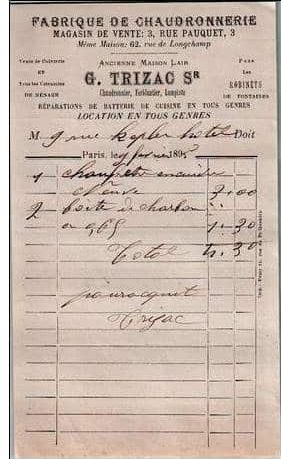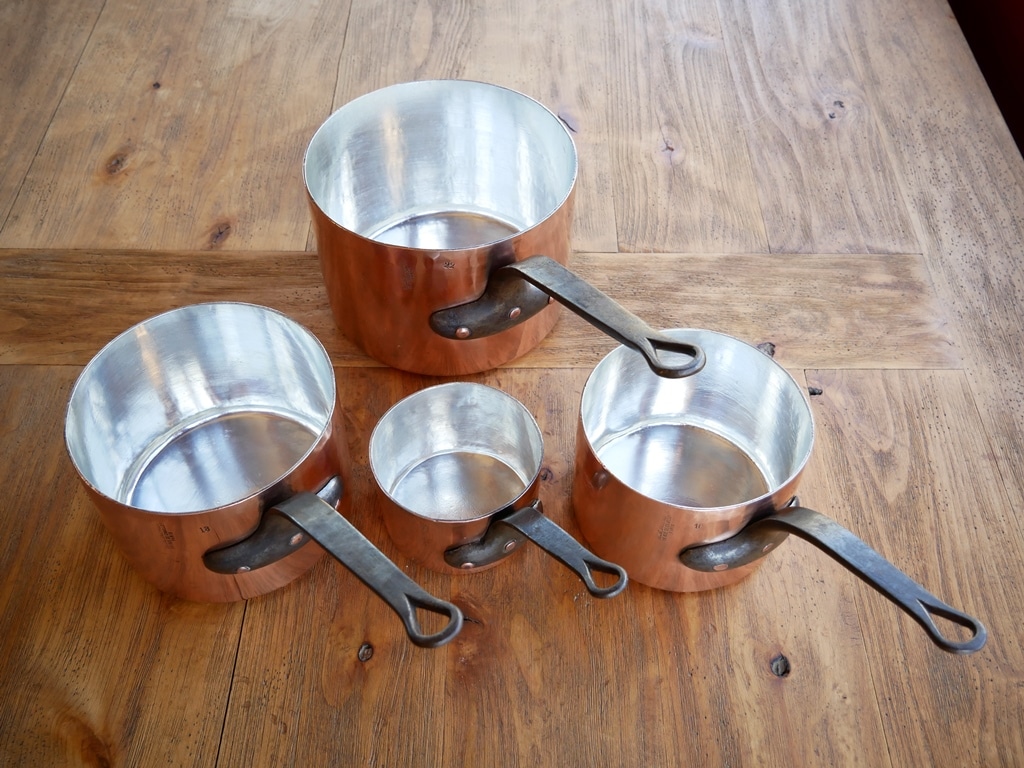These beautiful saucepans and lids are everyday masterpieces from a lesser-known Parisian atelier.

| Type | Four tin-lined saucepans in lightly hammered finish with iron handles attached with three copper rivets; lollipop lids with iron handles attached with two copper rivets | |||
| French description | Quatre sauciers étames et martelés avec queue de fer munie de trois rivets en cuivre; couvercles plats avec queue de fer munie de deux rivets en cuivre | |||
| Dimensions | 12cm by 8.2cm (4 ¾” x 3 ¼”) |
16cm by 11.4cm (6 ¼” x 4 ½”) |
18cm by 12.4cm (7 ⅛” x 5”) |
22cm by 15.2cm (8 ½” x 6”) |
| Thickness | 2.4mm | 2.4mm | 3.0mm | 3.0mm |
| Weight | 2 lbs, 3 oz (992g) |
5 lbs, 2 oz (2325g) |
7 lbs, 8 oz (3402g) |
10 lbs, 7 oz (4734g) |
| Stampings | All: “TRIZAC 3, RUE PAUQUET 59, RUE DE CHAILLOT PARIS”; “C.E.” | |||
| “13” on lid | “16”; “B” “17” on lid |
“18” “19” on lid |
“22” “23” on lid |
|
| Maker and age estimate | Trizac; 1890-1910s | |||
| Owners | Donna and Steve L. | |||
These lovely pieces carry an uncommon stamp: Trizac, a lesser-known chaudronnerie in Paris at the end of the 19th century.

Georges Trizac was born in 1864 in Paris. In 1888, just 24 years old, he purchased the chaudronnerie Lair at 51 Rue de Chaillot at the edge of the 16th arrondissement, south of the Arc du Triomphe, and began his own firm. In addition to the workshop on Rue de Chaillot, there was a storefront was at 3 Rue Pauquet (the present-day Rue Jean Giraudoux) and a second location at 62 Rue de Longchamp.
His first wife, Virginie Marie Costes, passed away in 1892 and Georges remarried Marie Guy that same year. Georges and Marie operated the chaudronnerie together until about 1905; my guess is that Georges passed away, as the proprietor was listed thereafter as Madame Trizac.
Marie continued the business until 1911 or so, when she sold the business to Jean Baptiste Georges Altier. By 1914, the Trizac business changed from chaudronnier to étameur — from coppersmithing to tinning — and moved from 3 to 9 Rue Pauquet. But this was no true retirement — Marie continued as étameur for several more years until at least 1928, the final commercial record I can find online.
 The Trizac stamp is three lines of text with both the 3 Rue Pauquet and 59 Rue de Chaillot addresses. This linear style is similar to stamps of the same period from Dehillerin and Jules Gaillard.
The Trizac stamp is three lines of text with both the 3 Rue Pauquet and 59 Rue de Chaillot addresses. This linear style is similar to stamps of the same period from Dehillerin and Jules Gaillard.
The pots themselves are beautiful in the classic French style. The surface of the copper retains the hammer marks of its martelage, softened somewhat from repeated retinnings and polishings, but still catching the light beautifully.

But it was not their beauty that their owners loved first about them. Owner Steve L. has seen and handled multiple Dehillerin and Gaillard pieces and while he certainly appreciated their looks, it was the weight of these Trizacs that caught his attention — and specifically, how bottom-heavy they are. I have highlighted before how extra mass in the base of the copper pan is very desirable for cooking performance; many antique pans are thinner at the rim than at the base, a consequence of the hand-crafting that shaped them from a flat sheet of thick copper.
These Trizac pots appear to be examples of this phenomenon. Consider that the 12cm pot measures 2.4mm at the rim, and yet at 992g weighs almost as much as my 3mm pot of the same diameter; the 16cm Trizac, also 2.4mm at the rim, weighs about 300g more than my equivalent 3mm pot. The difference grows with the diameter of each pot: the 18cm, 3mm at the rim, weighs almost 1000g more than an equivalent modern 3mm pot, and the 22cm is about 800g more. This extra copper gives these pots the cooking characteristics of a much thicker pan and will make them a pleasure to use.
And on top of all that, let’s face it — they’re easy on the eyes. The iron handles have a hanging loop in the French teardrop style, beautifully finished to a subtle point.

The interior rivets are set flush to the surface.

The lids are lovely as well. Each is stamped with its diameter in centimeters (13, 17, 19, and 23) and the initials “C.E” for a prior owner.


They have been restored by Val Maguire at Southwest Hand Tinning and she did lovely work with them, as the before and after photos below show.


I’d like to thank Donna and Steve for sharing these pieces with us, and Val for her careful and thoughtful restoration. (And Val also provided the great photos!) These pans have a spirit to them, I think, and it is a pleasure to see how beautifully they were made and how lovingly they have been kept. I wish their new owners many more happy years of cooking with them!





